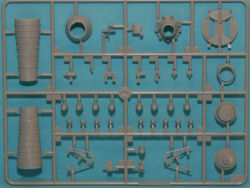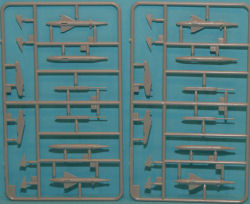
Hobby Boss 1/48 MiG-17PFU Fresco E Kit First Look
By Michael Benolkin
| Date of Review | April 2009 | Manufacturer | Hobby Boss |
|---|---|---|---|
| Subject | MiG-17PFU Fresco E | Scale | 1/48 |
| Kit Number | 80337 | Primary Media | Styrene |
| Pros | Nicely detailed kit | Cons | |
| Skill Level | Novice | MSRP (USD) | $38.99 |
First Look
 |
 |
 |
 |
 |
 |
 |
 |
The MiG-17 was an incremental design improvement based upon the experiences gained from MiG-15 flight operations. The MiG-17 was powered by the same Klimov VK-1 as the MiG-15, but the fuselage was lengthened about three feet and the wings were swept an additional 10 degrees to 45 degrees. The design changes resulted in a faster aircraft that was more maneuverable at altitude. Nevertheless, if you walked around a flightline of MiG-15 and MiG-17 aircraft, the design changes were subtle enough to make it difficult to distinguish between the two types until you count wing fences (two per wing on the MiG-15, three per wing on the MiG-17).
The Klimov VK-1, which was a license-built Rolls Royce Nene, was further enhanced with the first generation of afterburning engine, the VK-1F, giving its host aircraft additional thrust at critical phases of flight at the expense of much higher fuel consumption. The first afterburning MiG-17 became the MiG-17F.
Another distinction was given to the MiG-17 - development of smaller radar sets allowed for a radome to be added to the nose of the aircraft providing the pilot with limited all-weather intercept capability. These radar-equipped aircraft were designated as MiG-17P, and when equipped with both radar and the afterburning VK-1F, became the MiG-17PF.
Yet another development was the Soviets' first operational air-to-air missile - the beam-riding K-5 (AA-1 Alkalai). The MiG-17PF could engage its target with unguided rockets and cannon fire, but with the introduction of the K-5, the pilot could simply aim the pipper at the target and fire the missile. The K-5 would follow the beam of the radar to impact. In order to carry four K-5 missiles, the MiG-17 had to shed its cannons to allow for the weight of the missiles. These missile-equipped interceptors became the MiG-17PFU.
Hobby Boss has released several MiG-17s into their catalog and I thought it appropriate to look over this latest installment, the MiG-17PFU. If you look at the image of the second sprue tree, you can see the sides of the nose section as well as two different parts for the underside of the nose. The one without the cannons will be used with the MiG-17PFU but the cannon-nosed MiG-17PF is there as well.
The kit is molded in light gray styrene and presented on seven parts trees, plus a two trees of clear parts. The tooling is based upon the design of Trumpeter's 1/32 MiG-17s and is just as nicely done. As with the Trumpeter kit, the surface detailing is sharp and there is no sign of the mad riveter at work on this set of tooling.
The kit has a nicely appointed cockpit that only needs some photo-etched seat belts and shoulder harnesses for the ejection seat to make it look right. The kit also has a nicely detailed VK-1F engine complete with detailed engine mounts, none of which you'll see if you install the tail cone.
The instructions have you install the engine subassembly into the tail section before mating the rear fuselage to the forward fuselage. This is fine if you are going to conceal that nice looking engine, but you might consider leaving off the tail cone and mounting the engine mounting frame into the rear of the forward fuselage instead. The fuselage is divided right at the real maintenance break so you're revealing the aircraft at the right location, though you'll have to make a dolly to hold the tail and make a few other tweaks to make it all look right.
So what do we have for features and options in this kit? Let's take a look:
- Detailed cockpit
- Detailed engine and engine mount
- Separate tail section
- Positionable elevators, ailerons and flaps
- Positionable canopy
- PF and PFU lower nose pans
- Positionable speed brakes
- Four K-5 missiles and pylons
- Two external fuel tanks
Not a bad line-up straight out of the box.
Markings are provided for three examples:
- MiG-17PFU, Red 17, Soviet AF
- MiG-17PFU, Red 05, Soviet AF
- MiG-17PFU, Red 09, Soviet AF
These are all bare metal aircraft though you can probably find some camouflaged examples as they appeared near the end of their operational lives or within non-Soviet air arms.
I'm happy to see these MiGs scaled down from their 1/32 scale cousins. While Trumpeter did a great job with their larger kits, it is nice to have similar features and details in a smaller scale.
My sincere thanks to HobbyLink Japan for this review sample!







